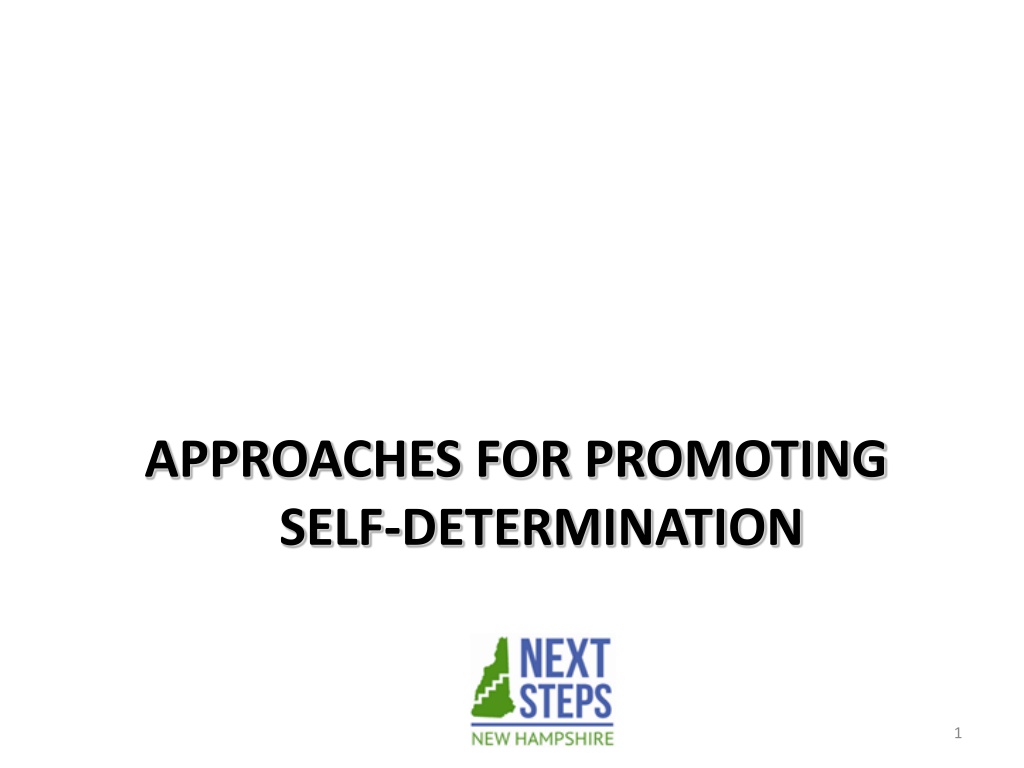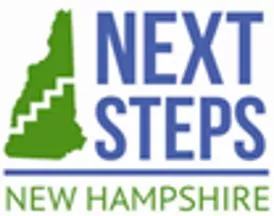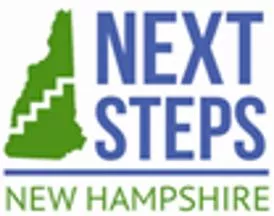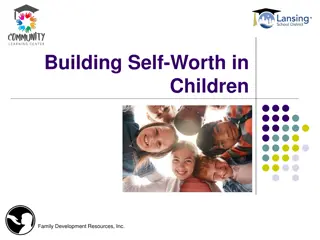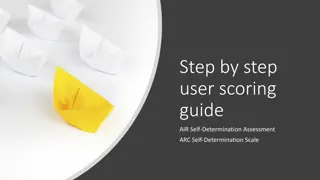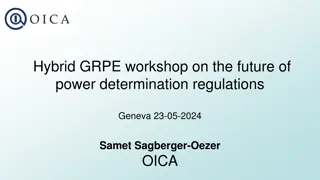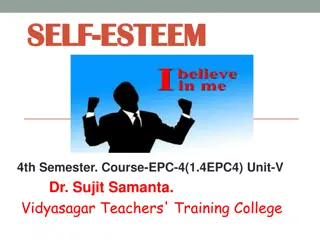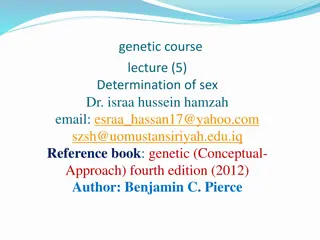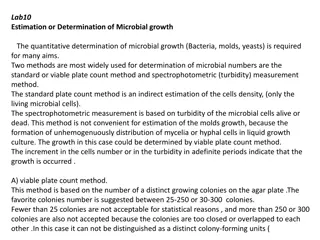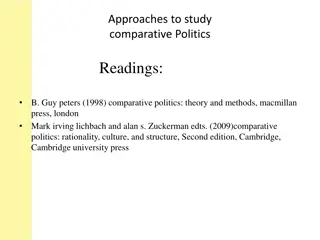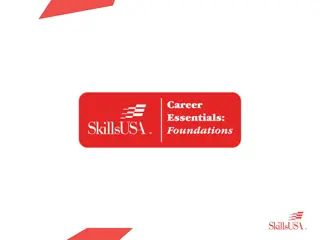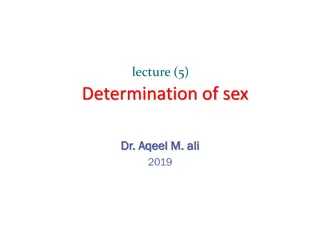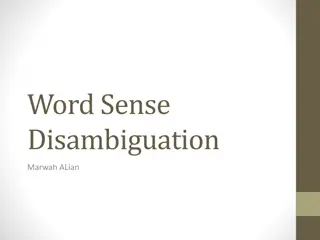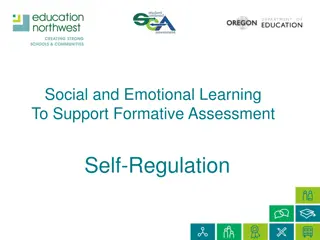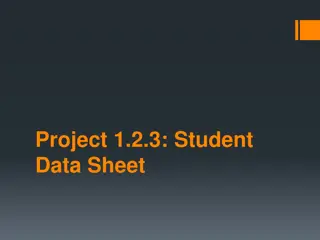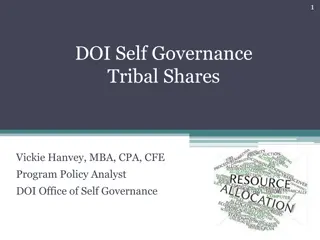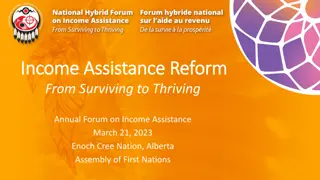Approaches for Promoting Self-Determination in Students
Four key approaches for promoting self-determination in students include utilizing student-driven IEP and transition planning, directly teaching skills or enhancing knowledge, embedding instruction into the general curriculum, and employing Person-Centered Planning. These strategies aim to empower students to take control of their own decisions and goals, ultimately fostering independence and self-advocacy skills.
Download Presentation

Please find below an Image/Link to download the presentation.
The content on the website is provided AS IS for your information and personal use only. It may not be sold, licensed, or shared on other websites without obtaining consent from the author.If you encounter any issues during the download, it is possible that the publisher has removed the file from their server.
You are allowed to download the files provided on this website for personal or commercial use, subject to the condition that they are used lawfully. All files are the property of their respective owners.
The content on the website is provided AS IS for your information and personal use only. It may not be sold, licensed, or shared on other websites without obtaining consent from the author.
E N D
Presentation Transcript
APPROACHES FOR PROMOTING SELF-DETERMINATION 1
Four Approaches for Promoting SD in Students Use student-driven IEP and transition planning. 2. Directly teaching skills or enhancing knowledge 3. Embedding instruction into the general curriculum 4. Use Person-Centered Planning 1. 2
Approaches for Promoting SD in Students 1. Student-driven IEP and transition planning Making sure the student attends and is PREPARED for participating in their IEP meetings Important step in transferring decision- making power to students Teaching students about the IEP and its use in guiding their future Remember that ALL students are capable of participating 3
Approaches for Promoting SD in Students 2. Directly teaching skills or enhancing knowledge Self-management (self-monitoring, self- recording, self-graphing, ) Choice-making Problem-solving 4
Approaches for Promoting SD in Students 3. Embedding instruction into the general curriculum Examples: a. Literature Circles b. IEP Template c. Go 4 It Now! d. Self-Determined Learning Model of Instruction (SDLMI) 5
Approaches for Promoting SD in Students 3a. Embedding in Curriculum: Literature Circles Description and Practice In small groups, students read the same book and prepare for the literature circle discussions by assuming different group roles and completing assignment sheets that prepare them for their role in the discussion. Self-determination components addressed: problem-solving and decision-making ELA skills addressed: reading comprehension, oral communication 6
Approaches for Promoting SD in Students 3 b. Embedding in Curriculum: IEP Template IEP awareness, career exploration and students interviewing parents and teachers Direct instruction and modeling to complete an IEP Template that includes vision statement; present level of performance; goals and objectives; measurement criteria and procedures; and services and accommodations Self-determination components addressed: goal- setting and self-awareness ELA skills addressed: research skills, writing for a variety of purposes, sentence writing 7
Approaches for Promoting SD in Students 3c. Embedding in Curriculum: GO 4 IT NOW! Uses a mnemonic device to help students write 6-sentence goal paragraphs Can be applied to other types of paragraph writing Self-determination components addressed: goal-setting, self- awareness, and self-regulation ELA skills addressed: writing for a variety of purposes, paragraph writing Goals Objectives 4 (4 objectives) Identify Timeline Name your topic. Order your steps. Wrap it up and restate topic. 8
Approaches for Promoting SD in Students 3d. Embedding in Curriculum: Self-Directed Learning Model of Instruction Mithaug, Wehmeyer, Agran, Martin, & Palmer, (1998). Three phases: Phase 1: Set a Goal Phase 2: Take Action Phase 3: Adjust Goal or Plan Used for setting academic and behavior goals 9
Approaches for Promoting SD in Students 4. Person-Centered Planning A facilitated process designed to plan and develop supports to meet the specific desires of the focal person. First, a group (or circle) of individuals is identified by the student and family who have an interest in funding or providing supports for the student. Second, the group meets at a place convenient for all members (often a home or restaurant) to develop a plan. 10
Approaches for Promoting SD in Students 4. Person Centered Planning Some Types of PCP Whole-Life Planning (Timmons & Whitney- Thomas, 1998) Personal Futures Planning (Miner & Bates, 1997) McGill Action Planning System (Vandercook, York, & Forest, 1989). 11
Approaches for Promoting SD in Students McGill Action Planning System (MAPS) 1. What is the individual s history? 2. What is your dream for the future? 3. What is your nightmare? 4. Who is the individual? 5. What are the individual s strengths, gifts, and abilities? 6. What are the individual s needs? 7. What would the individual s ideal day at school look like? 8. What must be done to make it happen? 12
What self-determination teaching or assessment practices are used in your department? What practices are used schoolwide? Are the outcomes of practices being documented as transition assessment? ACTIVITY 2 13
PUBLISHED RESEARCH-BASED CURRICULA IN SELF-DETERMINATION 14
Next S.T.E.P. (Student Transition & Educational Planning) Population: All levels of disability Ages 14 through 21 Purpose: Helps students learn how to take charge of their own transition planning process Helps students assume responsibility for important life decisions with support from teachers and parents Materials: 16 lessons with fully developed lesson plans 15
Next S.T.E.P. , continued (Student Transition & Educational Planning) Content: Unit 1: Getting to Know Myself Unit 2: Self-Evaluation Unit 3: Setting and Achieving Goals Unit 4: Sharing Your Goals and Accomplishments For further information: Available through ProEd $215.00 16
Whose Future Is It Anyway? A Student-Directed Transition Planning Process Purpose: Prepare students for their IEP meetings and gain self-determination skills Population: students with mild to moderate cognitive disabilities Materials: Coach's Guide outlines lessons how to teach lessons the roles of the students and teachers expected outcomes 17
Whose Future Is It Anyway?, cont. Content Sections include: Getting to know you; Making Decisions; How to Get What You Need; Goals, Objectives and the Future ; Communicating; Thank You, Honorable Chairperson http://www.ou.edu/education/centers-and- partnerships/zarrow.html - Select Transition Education Materials FREE!!!! 18
ME! Lessons Purpose: Teaching Self-Advocacy and Self- Awareness Unit overviews, Common Core State Standards, and lesson plans are included in one file http://www.ou.edu/education/centers-and- partnerships/zarrow.html Select Transition Education Materials FREE!!!! 19
Next Steps NH Student Training Adapted from ME! Empowering Youth: It s all about you! It s your IEP it s your life! Taking it to the next step; pulling it all together. 20
FIND EVIDENCE-BASED PRACTICES (EBP) IN SELF-DETERMINATION 21
Where to Find EBPs and more National Technical Assistance Center on Transition transitionta.org/ Effective Practices Lesson Plans Zarrow Center Assessments and lessons http://www.ou.edu/education/centers-and- partnerships/zarrow.html 22
Where to Find EBPs and more Youthhood Dynamic, curriculum- based tool that can help young adults plan for life after high school. http://www.youthhood. org/index.asp Interactive and personalized Directed to young adults I am Determined! http://www.imdetermin ed.org/ Direct instruction, models, and skill practice Pepnet http://www.pepnet.org For deaf or hard of hearing students, ages 14 through adult. Changes coming January 1, 2017 23
What does teaching self What does teaching self- -determination skills look like? look like? determination skills Welcome to my IEP meeting. Meet Parker Bryant Today we are going to talk about my plans for the future. 24
Ideas for Implementation Include discussions of self-determination skills in IEP and other student meetings Select a basic SD assessment tool and pilot with selected group of students Pilot Student Led IEPs Use self-determination practices in a specific class 25
Ideas for Implementation Add self-determination transition services and annual goals to IEPs Provide the Next Steps NH Courses in a train-the-trainer format for sustainability Offer the Next Steps NH courses as: A mini-ELO, single or group A mini-course 8th grade orientation workshops 26
Part 3: Goals and Action Plans Consider your discussions in Activities 1 & 2. What is your goal for increasing and improving self-determination practices in your school ACTIVITY 3 27
Next Steps NH Transition Resource Portal Today s training and materials will be available at: www.nextsteps-nh.org 28
Thank You! The contents of this presentation were developed under a grant from the US Department of Education, H323A120003. However, those contents do not necessarily represent the policy of the US Department of Education, and you should not assume endorsement by the Federal Government. Project Officer, Corinne Weidenthal. This product is public domain. Authorization to reproduce it in whole or in part is granted. While permission to reprint is not necessary, the citation should be: NH State Personnel Development Grant Next Steps NH (2012-2017). New Hampshire Department of Education, Concord.
